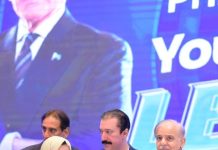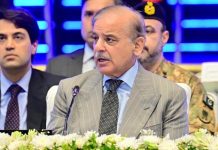DM Monitoring
LUCKNOW: An Indian court on Wednesday acquitted Hindu nationalist leaders, including former deputy prime minister Lal Krishna Advani, in a case over the demolition of a mosque at a disputed site 28 years ago, citing a lack of evidence.
The demolition sparked nationwide riots that killed more than 3,000 people in a decades-long dispute that has fueled Hindu-Muslim tension, as the ruling Bharatiya Janata Party’s campaign for Hindu renaissance helped bring it to power.
A special Central Bureau of Investigation court in Lucknow in its Wednesday ruling said that the demolition was not pre-planned and that the people who demolished the mosque were “anti-national elements”.
The court pinned the blame on miscreants mingled among the crowd instead, adding that leaders such as Advani and Murli Manohar Joshi, another former cabinet minister, had tried to keep the mob from turning violent.
Handing down its verdict after a lengthy legal battle, the court said there was not enough evidence to directly tie any of the accused to the violence, defence lawyer Manish Kumar Tripathi said.
“The court did not accept the evidence, it was not strong enough,” Tripathi told reporters at the courthouse.
The court had ignored all the evidence in Wednesday’s case, said Zafaryab Jilani, a lawyer for the All India Muslim Personal Law Board, adding that it planned to appeal to the high court against the decision. “We will seek remedy,” he added. ‘Indian judiciary miserably fails to deliver justice again’
Reacting to the verdict, Pakistan strongly condemned the “shameful” acquittal of those responsible for demolishing the historic Babri Masjid in Ayodhya.
“Taking almost three decades to decide on the criminal act which was televised live and happened as a result of well-planned Rath Yatras and on the instigation to mobs by the accused BJP, VHP and other leaders of Sangh Parivar, tells the world that the Hindutva-inspired Indian judiciary miserably failed to deliver justice again,” said a statement by the Ministry of Foreign Affairs.
“The demolition of the mosque had resulted in BJP-led communal violence leading to thousands of killings. If there was a semblance of justice in the so-called largest ‘democracy’, the individuals, who had boasted of the criminal act publicly, could not have been set free. “The Rashtriya Swayamsevak Sangh-BJP regime and the Sangh Parivar are responsible for the continued desecration and demolition of mosques in India in an organised manner as they did during the Gujarat massacre of 2002 and Delhi pogrom in 2020.” Pakistan urged the Indian government to ensure safety, security and protection of minorities, particularly Muslims and their places of worship and other Islamic sites “on which the Hindu extremists and zealots have laid claims”.
Advani, who was then BJP chief, was among 32 people accused of criminal conspiracy and inciting a mob to tear down the 16th century Babri mosque in the northern town of Ayodhya in 1992. The mosque stood on a site revered by devout Hindus as the birthplace of Ram.
Last month, Prime Minister Narendra Modi laid the foundation stone for a Hindu temple to be built at the site, after the Supreme Court paved the way last year, in a decision that also ordered land to be allotted further away for a mosque. Pakistan, called the top court verdict “a flawed judgement”, had said: “A temple built on the site of a historic mosque will remain a blot on the face of the so-called Indian democracy for the times to come.”
Moreover, Few cases have captured public attention, polarised watchers and dragged on for longer than the this one has. The mosque in Ayodhya was demolished on December 6, by ‘kar sevaks’ who claimed that an ancient Ram temple stood at the same site. Last year, a five-judge Constitution bench of the top court had ruled that the 2.77-acre land claimed by both Hindus and Muslims would be handed over to a trust for the building of a temple. Among accused are several leaders of the Bharatiya Janata Party, in power at the Centre today. The 32 accused include former deputy prime minister L.K. Advani, along with Murli Manohar Joshi, Kalyan Singh and Uma Bharti, who have all been asked to be present in court.
The following timeline attempts to offer an idea of the events that led to the demolition and those that shaped how it will be seen in history:
1528: The Babri Masjid is built in Ayodhya by Mir Baqi, upon the instructions of the Mughal emperor, Babur.
1855: Sunni Muslims claim the temple of Hanumangarhi in Ayodhya is built on the site of a destroyed mosque. Clashes begin between them and Bairais, but Nawad Wajid Ali Shah is believed to have intervened on behalf of the temple to maintain peace.
1859: The British administration erects a fence around Babri Masjid, as the belief that the mosque is the birthplace of Ram gains currency. Hindus are allowed to worship in the outer court.
1885: Mahant Raghubir Das’s plea to build a worshipping platform in this outer courtyard is rejected by a local court.
March 1934: The mosque and its dome sustain damages during violence between Hindus and Muslims. The British government takes up rebuilding efforts.
1947: A local court rules that it is the Sunni Waqf Board and not the Shia Waqf Board that can hold sway over the Babri Masjid.
December 22, 1949: District Magistrate K.K. Nayar refuses to remove idols of Ram placed inside the mosque by Hindu Mahasabha members, citing possibility of riots. Nayar eventually joins the Jan Sangh and becomes an MP. The mosque comes under lock and key
1950: Muslim and Hindu parties file suits in Faizabad court, asking for permission for namaz and prayers, respectively. The inner courtyard remains locked. An interim injunction allows a pujari in but forbids entry to others.
1959: A third suit is filed in the same court by the Nirmohi Akhara, headed by Mahant Bhaskar Das, which asks for pujas to be conducted even on the disputed grounds.
1961: The UP Sunni Central Waqf Board files a fourth suit in the same court, asking for Muslims to be allowed to pray in the mosque.
1981: The above board files for possession of the site.
1984: As the ‘Ram Janmabhoomi’ movement gathers steam, L.K. Advani of the new political player Bharatiya Janata Party, becomes its de facto leader. The Vishwa Hindu Parishad leads a Shriram-Janaki rath yatra from Sitamarhi in Bihar to Delhi. Six similar yatras take place in Uttar Pradesh. BJP wins only two seats out of 541 in the Lok Sabha polls.
1986: A district judge according to historian Ramachandra Guha, under orders from the PMO directs that the Babri Masjid gates be unlocked and Hindus be allowed to worship there. In protest, Muslims set up the Babri Masjid Action Committee. Parliament passes the Muslim Women (Protection of Rights on Divorce) Act, 1986, effectively overturning the Supreme Court verdict in the Shah Bano case, a crucial factor that paved the way for BJP’s participation in the Ayodhya movement, according to Advani, who became party chief in that year..
1989: Allahabad high court orders maintenance of status quo with respect to the Babri Masjid after a fresh suit is filed by VHP vice-president and former judge of the court Deoki Nandan Agarwal seeking to become the “sakha” or friend of the deity and its birthplace in the title suits
November 9, 1989: Rajiv Gandhi government allows the VHP to perform shilanyas (laying of the foundation stone) for the Ram temple on November 9, 1989, on the disputed land.
September 25, 1990: BJP President L.K. Advani launches his Rath Yatra from Somnath to Ayodhya to gather support for the Ram temple. He is arrested in Samastipur in Bihar by the government of Lalu Prasad Yadav in November, 1990. Vishwa Hindu Parishad leader Ashok Singhal is also arrested.
October 30, 1990: Kar sevaks clash with the police on their way to Ayodhya’s Babri Masjid and at least 20 are killed. Communal clashes rock Uttar Pradesh.
1991: BJP, which had withdrawn support to the V.P. Singh government, emerges as the second-largest party with 121 seats in the Lok Sabha following the general elections. In Uttar Pradesh, Kalyan Singh heads the BJP government.
December 6, 1992: A crowd of almost 150,000 people gather to listen to speeches by BJP and the Vishwa Hindu Parishad (VHP) leaders including LK Advani and Murli Manohar Joshi – at the Babri Masjid in Ayodhya. The crowd later storms the mosque and demolishes it in a few hours. The demolition occurred despite assurances from the state government to the Supreme Court that the mosque would not be harmed.
After the demolition of the Babri Masjid, on the evening of December 6, 1992, kar sevaks started attacking Muslim residents of Ayodhya, ransacking and demolishing their houses. Eighteen Muslims were murdered, almost all their houses and shops were torched and destroyed, including 23 local mosques. Additionally, riots broke out in different parts of the country, including Mumbai, and around 2,000 people were killed. Two FIRs are filed, one against kar sevaks for the demolition and the other against the likes of Advani, Joshi and Bharti, for the communal speeches they delivered that led to the demolition.
December 8, 1992: Muslims in Pakistan attack more than 30 Hindu temples. Pakistan government closes offices and schools for a day in protest against the destruction of the mosque in India.
December 16, 1992: The Narasimha Rao government sets up the Liberhan Commission to investigate the case.
1993: The Centre acquires 67.703 acres of land in and around the Babri Masjid under the newly passed ‘Acquisition of Certain Area at Ayodhya Act’. CBI takes over the criminal case. A chargesheet is filed against Advani and 19 others for inciting the demolition.
1994: The Supreme Court finds UP chief minister Kalyan Singh guilty, sentences him to token imprisonment of one day with a fine of Rs 20,000.
2001: An NDA government is at the Centre now. A special CBI court drops proceedings and conspiracy charges against the accused including Advani, M.M. Joshi, Uma Bharti, Bal Thackeray and others.
2002: PM Vajpayee sets up an ‘Ayodhya cell’ in his office and appoints a senior official, Shatrughan Singh, to hold talks with Hindu and Muslim leaders. While BJP does not commit itself to a Ram temple in its Uttar Pradesh assembly election manifesto, VHP sets a deadline of March 15 to begin construction. Hundreds of volunteers converge on site. The Allahabad high court directs the Archaeological Survey of India to excavate the Babri Masjid site to determine if a temple lay underneath.
2003: The ASI submits a report, refuted by archaeologists and historians, saying that there is evidence of a 10th century temple beneath the mosque. CBI special court rules that seven Hindutva leaders should stand trial for inciting the destruction of the Babri Mosque, but no charges are brought against Advani, now deputy prime minister, who was also at the site in 1992.
2004: The court rules that the earlier order which exonerated Advani for his role in the destruction of the mosque should be reviewed.
2005: Six suspected Lashkar-e-Taiba terrorists attack the disputed Ram Janambhoomi complex in Ayodhya.
2009: The Liberhan commission submits its report, 17 years after it began its inquiry. The Commission finds several BJP leaders like Atal Bihari Vajpayee, Lal Krishna Advani, Murli Manohar Joshi, Kalyan Singh, Pramod Mahajan, Uma Bharti and Vijayaraje Scindia, and VHP leaders like Giriraj Kishore and Ashok Singhal and Shiv Sena chief Bal Thackeray and former RSS leader K. N. Govindacharya culpable in the demolition of the mosque.
2010: Allahabad high court rules that the disputed land in Ayodhya where the Babri Masjid was shall be divided into three parts. A two-thirds portion is to be shared by two Hindu plaintiffs and one-third will be given to the Sunni Muslim Waqf Board.




